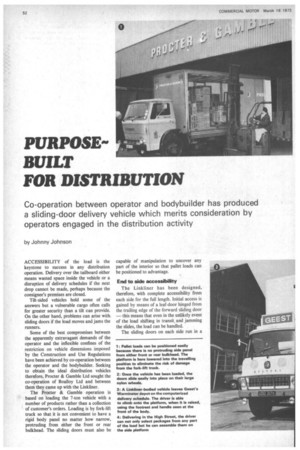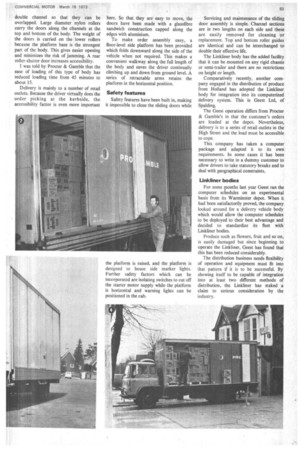PURPOSE" BUILT FOR DISTRIBUTION
Page 54

Page 55

If you've noticed an error in this article please click here to report it so we can fix it.
Co-operation between operator and bodybuilder has produced a sliding-door delivery vehicle which merits consideration by operators engaged in the distribution activity
by Johnny Johnson ACCESSIBILITY of the load is the keystone to success in any distribution operation. Delivery over the tailboard either means wasted space inside the vehicle or a disruption of delivery schedules if the next drop cannot be made, perhaps because the consignee's premises are closed.
Tilt-sided vehicles hold some of the answers but a vulnerable cargo often calls for greater security than a tilt can provide. On the other hand, problems can arise with sliding doors if the load moves and jams the runners.
Some of the best compromises between the apparently extravagant demands of the operator and the inflexible confines of the restriction on vehicle dimensions imposed by the Construction and Use Regulations have been achieved by co-operation between the operator and the bodybuilder. Seeking to obtain the ideal distribution vehicles therefore, Procter & Gamble Ltd sought the co-operation of Boalloy Ltd and between them they came up with the Linkliner.
The Procter & Gamble operation is based on loading the 7-ton vehicle with a number of products rather than a collection of customer's orders. Loading is by fork-lift truck so that it is not convenient to have a rigid body panel no matter how narrow, protruding from either the front or rear bulkhead. The sliding doors must also be capable of manipulation to uncover any part of the interior so that pallet loads can be positioned to advantage.
End to side eccessibiRty The Linkliner has been designed, therefore, with complete accessibility from each side for the full length. Initial access is gained by means of a leaf-door hinged from the trailing edge of the forward sliding door — this means that even in the unlikely event of the load shifting in transit and jamming the slides, the load can be handled.
The sliding doors on each side run in a
double channel so that they can be overlapped. Large diameter nylon rollers carry the doors along the channels at the top and bottom of the body. The weight of the doors is carried on the lower rollers because the platform base is the strongest part of the body. This gives easier opening and minimizes the risk of jamming. A rear roller-shutter door increases accessibility.
I was told by Procter & Gamble that the ease of loading of this type of body has reduced loading time from 45 minutes to about IS.
Delivery is mainly to a number of retail outlets. Because the driver virtually does the order picking at the kerbside, the accessibility factor is even more important here. So that, they are easy to move, the doors have been .made with a glassfibre sandwich construction capped along the edges with aluminium.
To make order assembly easy, a floor-level side platform has been provided which folds downward along the side of the vehicle when not required. This makes a convenient walkway along the full length of the body and saves the driver continually climbing up and down from ground level. A series of retractable arms retains the platform in the horizontal position.
Safety features Safety features have been built in, making it impossible to close the sliding doors while Servicing and maintenance of the sliding door assembly is simple. Channel sections are in two lengths on each side and these are easily removed for cleaning or replacement. Top and bottom roller guides are identical and can be interchanged to double their effective life.
The Linkliner body has the added facility that it can be mounted on any rigid chassis or semi-trailer and there are no restrictions on height or length.
Comparatively recently, another company engaged in the distribution of produce from Holland has adopted the Linkliner body for integration into its computerized delivery system. This is Geest Ltd, of Spalding.
The Geest operation differs from Procter & Gamble's in that the customer's orders are loaded at the depot. Nevertheless, delivery is to a series of retail outlets in the High Street and the load must be accessible to cope.
This company has taken a computer package and adapted it to its own requirements. In some cases it has been necessary to write in a dummy customer to allow drivers to take statutory breaks and to deal with geographical constraints.
Linkliner bodies For some months last year Geest ran the computer schedules on an experimental basis from its Warminster depot. When it had been satisfactorily proved, the company looked around for a delivery vehicle body which would allow the computer schedules to be deployed to their best advantage and decided to standardize its fleet with Linkliner bodies.
Produce such as flowers, fruit and so on, is easily damaged but since beginning to operate the Linkliner, Geest has found that this has been reduced considerably.
The distribution business needs flexibility of operation and equipment must fit into that pattern if it is to be successful. By showing itself to be capable of integration into at least two different methods of distribution, the Linkliner has staked a claim to serious consideration by the industry.
























































































































